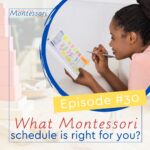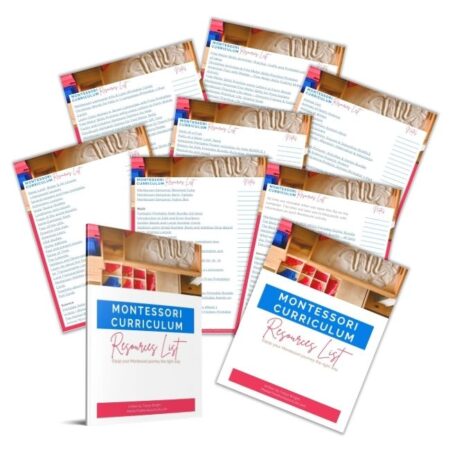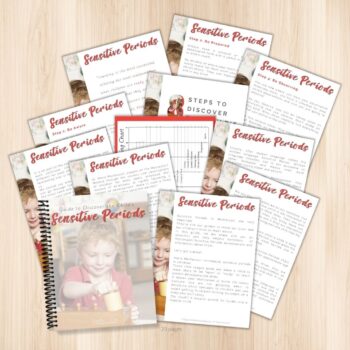
In order to remain confident and effective while following the proper Montessori schedule, there are three extremely crucial things to accomplish.
Full video training here:
The Montessori Learning Day
The Montessori learning day can be divided into three distinct and more technical parts: The Absorbent Mind, Sensitive Periods, and Normalization.
Each part of the day has a different purpose in the child’s development, and as such, each part should be approached differently.
The Absorbent Mind
The first part of the Montessori Learning Day is the Absorbent Mind period.
This is when the child is absorbing information like a sponge.
They are taking in everything around them and learning at an astounding rate.
Because of this, it is important to provide a stimulating environment during this time.
This can be done through educational materials, books, music, movement, and conversation.
It is also during this time that children learn best through hands-on experiences.
This is because they are able to physically manipulate their surroundings and gain a greater understanding of the world around them.
Sensitive Periods
The second part of the Montessori Learning Day is the Sensitive Periods.
This is when the child is focused on developing specific skills.
These skills can be anything from language and communication, to math and problem solving.
During this time, it is important to provide materials and activities that will challenge the child and help them to develop these skills.
It is also during this time that children learn best through teacher-led activities.
This is because the teacher is able to guide the child through each step of the activity, providing them with the support they need to succeed.
Normalization in Children
The third part of the Montessori Learning Day is Normalization.
This is when the child is focused on developing independence and self-regulation.
During this time, it is important to provide materials and activities that will allow the child to practice these skills. It is also during this time that children learn best through independent work.
This is because they are able to work at their own pace and make their own choices.
By following the proper Montessori routine, you can be confident that your child is getting the most out of their learning day.
What is a Montessori Schedule?
A Montessori schedule is a routine that is designed to promote learning.
Each part of the day has a different purpose in the child’s development, and as such, each part should be approached differently.
Children like consistency and predictability.
They like to know what is coming next. It takes away the stress out of the schedule and it builds their confidence.
Three Distinct Parts
A Montessori schedule can be divided into three distinct parts: The Work Period, The Play Period, and The Rest Period.
The Work Period is when the child is focused on learning.
They are working on their academics or on a specific skill. During this time, it is important to provide materials and activities that will challenge the child and help them to learn.
It is also during this time that children learn best through teacher-led activities.
This is because the teacher is able to guide the child through each step of the activity, providing them with the support they need to succeed.
The Play Period is when the child is focused on playing.
They are exploring their surroundings and using their imagination.
During this time, it is important to provide materials and activities that will allow the child to play freely.
It is also during this time that children learn best through independent play.
This is because they are able to explore and discover on their own.
The Rest Period is when the child is focused on resting.
They are taking a break from their work and play to relax and rejuvenate.
During this time, it is important to provide a calm and comfortable environment for the child.
This can be done by dimming the lights, playing soft music, or providing a cozy blanket.
It is also during this time that children learn best through quiet activities.
This is because they are able to wind down and prepare for the next part of their day.
By following the proper Montessori routine, you can be confident that your child is getting the most out of their learning day.
Why You Should Have a Montessori Routine
First and foremost, you must find a schedule that works well for you specifically.
Secondly, you need to be flexible with your routine in order to avoid getting overwhelmed or bogged down.
Lastly, it is essential to keep a learning day mentality in order to make the most out of each and every day.
If you can adhere to these three guidelines, then you will be well on your way to having a successful Montessori experience!
#MasterTheMontessoriLifeShow #themontessoriwayfoundationsframework #themontessoriwaypreproom #themontessoriguide #themontessorimethod #themontessoriway #MasterTheMontessoriLife #montessori #montessoriathome #montessoritopics #montessorieducation #themontessorilife #themontessorijourney #themontessoriexperience #montessoripodcast #montessoripodcasts #montessoriprogram #centeredmontessoriguide #normalizedchild #montessoridays #montessorian #montessoriactivity #montessorienvironment #montessoriquestions #montessorihomeschool #montessorikids #montessorimom #montessoriactivities #montessorimaterials
Wardrobe from: http://bit.ly/TNHstitchfix





Leave a Reply